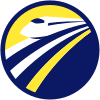Union Station (Los Angeles)
Los Angeles Union Station (LAUS) is the main railway station in Los Angeles, California, and the largest railroad passenger terminal in the Western United States.[3] It opened in May 1939 as the Los Angeles Union Passenger Terminal, replacing La Grande Station and Central Station, and celebrated its 80th birthday in 2019.[4]
Los Angeles Union Station | |||||||||||||||||||||||||||||||||||||||||||||||||||||||||||||||||||||||||||||||||||||||||||
|---|---|---|---|---|---|---|---|---|---|---|---|---|---|---|---|---|---|---|---|---|---|---|---|---|---|---|---|---|---|---|---|---|---|---|---|---|---|---|---|---|---|---|---|---|---|---|---|---|---|---|---|---|---|---|---|---|---|---|---|---|---|---|---|---|---|---|---|---|---|---|---|---|---|---|---|---|---|---|---|---|---|---|---|---|---|---|---|---|---|---|---|
| Amtrak, Metrolink and LA Metro station | |||||||||||||||||||||||||||||||||||||||||||||||||||||||||||||||||||||||||||||||||||||||||||
 Main building and gardens | |||||||||||||||||||||||||||||||||||||||||||||||||||||||||||||||||||||||||||||||||||||||||||
| Location | Amtrak/Metrolink 800 North Alameda Street Metro 801 Vignes Street Los Angeles, California 90012 United States | ||||||||||||||||||||||||||||||||||||||||||||||||||||||||||||||||||||||||||||||||||||||||||
| Coordinates | 34.05515°N 118.23525°W | ||||||||||||||||||||||||||||||||||||||||||||||||||||||||||||||||||||||||||||||||||||||||||
| Owned by | Los Angeles County Metropolitan Transportation Authority | ||||||||||||||||||||||||||||||||||||||||||||||||||||||||||||||||||||||||||||||||||||||||||
| Platforms | 6 island platforms (Amtrak/Metrolink) 1 island platform (Metro L Line) 1 island platform (Metro B/D Lines) 1 island platform (Metro J Line) | ||||||||||||||||||||||||||||||||||||||||||||||||||||||||||||||||||||||||||||||||||||||||||
| Tracks | 12 (Amtrak/Metrolink) 2 (Metro L Line) 2 (Metro B/D Lines) | ||||||||||||||||||||||||||||||||||||||||||||||||||||||||||||||||||||||||||||||||||||||||||
| Construction | |||||||||||||||||||||||||||||||||||||||||||||||||||||||||||||||||||||||||||||||||||||||||||
| Parking | 3,000 spaces | ||||||||||||||||||||||||||||||||||||||||||||||||||||||||||||||||||||||||||||||||||||||||||
| Bicycle facilities | 74 bike rack spaces 20 locker spaces | ||||||||||||||||||||||||||||||||||||||||||||||||||||||||||||||||||||||||||||||||||||||||||
| Disabled access | Yes | ||||||||||||||||||||||||||||||||||||||||||||||||||||||||||||||||||||||||||||||||||||||||||
| Other information | |||||||||||||||||||||||||||||||||||||||||||||||||||||||||||||||||||||||||||||||||||||||||||
| Station code | Amtrak code: LAX | ||||||||||||||||||||||||||||||||||||||||||||||||||||||||||||||||||||||||||||||||||||||||||
| Website | UnionStationLA.com | ||||||||||||||||||||||||||||||||||||||||||||||||||||||||||||||||||||||||||||||||||||||||||
| History | |||||||||||||||||||||||||||||||||||||||||||||||||||||||||||||||||||||||||||||||||||||||||||
| Opened | May 3, 1939 | ||||||||||||||||||||||||||||||||||||||||||||||||||||||||||||||||||||||||||||||||||||||||||
| Traffic | |||||||||||||||||||||||||||||||||||||||||||||||||||||||||||||||||||||||||||||||||||||||||||
| Passengers (2018) | 1,717,405[1] | ||||||||||||||||||||||||||||||||||||||||||||||||||||||||||||||||||||||||||||||||||||||||||
| |||||||||||||||||||||||||||||||||||||||||||||||||||||||||||||||||||||||||||||||||||||||||||
| |||||||||||||||||||||||||||||||||||||||||||||||||||||||||||||||||||||||||||||||||||||||||||
Los Angeles Union Passenger Terminal | |||||||||||||||||||||||||||||||||||||||||||||||||||||||||||||||||||||||||||||||||||||||||||
Los Angeles Historic-Cultural Monument No. 101 | |||||||||||||||||||||||||||||||||||||||||||||||||||||||||||||||||||||||||||||||||||||||||||
 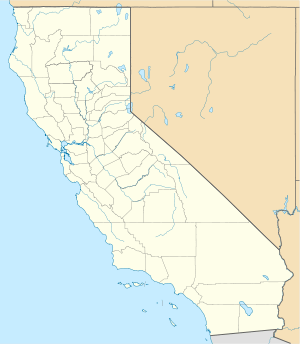  | |||||||||||||||||||||||||||||||||||||||||||||||||||||||||||||||||||||||||||||||||||||||||||
| Coordinates | 34.05515°N 118.23525°W | ||||||||||||||||||||||||||||||||||||||||||||||||||||||||||||||||||||||||||||||||||||||||||
| Built | 1939 | ||||||||||||||||||||||||||||||||||||||||||||||||||||||||||||||||||||||||||||||||||||||||||
| Built by | Robert E. McKee Inc. | ||||||||||||||||||||||||||||||||||||||||||||||||||||||||||||||||||||||||||||||||||||||||||
| Architect | Parkinson, John & Donald B. | ||||||||||||||||||||||||||||||||||||||||||||||||||||||||||||||||||||||||||||||||||||||||||
| Architectural style | Moderne, Art Deco, Mission/Spanish Revival | ||||||||||||||||||||||||||||||||||||||||||||||||||||||||||||||||||||||||||||||||||||||||||
| NRHP reference No. | 80000811[2] | ||||||||||||||||||||||||||||||||||||||||||||||||||||||||||||||||||||||||||||||||||||||||||
| LAHCM No. | 101 | ||||||||||||||||||||||||||||||||||||||||||||||||||||||||||||||||||||||||||||||||||||||||||
| Significant dates | |||||||||||||||||||||||||||||||||||||||||||||||||||||||||||||||||||||||||||||||||||||||||||
| Added to NRHP | November 13, 1980 | ||||||||||||||||||||||||||||||||||||||||||||||||||||||||||||||||||||||||||||||||||||||||||
| Designated LAHCM | August 2, 1972 | ||||||||||||||||||||||||||||||||||||||||||||||||||||||||||||||||||||||||||||||||||||||||||
Approved in a controversial ballot measure in 1926 and built in the 1930s, it served to consolidate rail services from the Union Pacific, Santa Fe, and Southern Pacific Railroads into one terminal station. Conceived on a grand scale, Union Station became known as the "Last of the Great Railway Stations" built in the United States. The structure combines Art Deco, Mission Revival, and Streamline Moderne style. It was placed on the National Register of Historic Places in 1980.
Today, the station is a major transportation hub for Southern California, serving almost 110,000 passengers a day.[5] It is Amtrak's fifth-busiest station, and by far the busiest in the Western United States and the tenth-busiest in the entire country. Four of Amtrak's long-distance trains originate and terminate here: the Coast Starlight to Seattle, the Southwest Chief and Texas Eagle to Chicago, and the Sunset Limited to New Orleans. The state-supported Amtrak California Pacific Surfliner regional trains run frequently to San Diego and also to Santa Barbara and San Luis Obispo. The station is the hub of the Metrolink commuter trains, and several Metro Rail subway and light rail lines serve it as well, with more in construction or planning.
The Patsaouras Transit Plaza, on the east side of the station, serves dozens of bus lines operated by Metro and several other municipal carriers.[6]
History
In 1926, a measure was placed on the ballot giving Los Angeles voters the choice between the construction of a vast network of elevated railways or the construction of a Union station to consolidate the city's two mainline railroad stations (Central Station and La Grande Station). The election took on racial connotations and become a defining moment in the development of Los Angeles. One proposed location for Union Station was located in the heart of what was Los Angeles' original Chinatown. Reflecting the racial prejudice of the time, Los Angeles Times, a lead opponent of elevated railways, argued in editorials that Union Station would not be built in the "midst of Chinatown" but rather would "forever do away with Chinatown and its environs." The Times also attacked the elevated railways for blocking out the California sun and in general being antithetical to the ethos of Los Angeles.[7]
Two questions were put to vote in 1926. First, the voters approved Union Station instead of elevated railways by 61.3 to 38.7 percent margin. Second, the electorate voted in favor of Los Angeles Plaza, not Chinatown, as the site of the new station, but by a much smaller 51.1 to 48.9 percent margin.[8]
However, largely due to the efforts of preservationist Christine Sterling and Los Angeles Times publisher Harry Chandler, Union Station would not replace the Plaza, but be built across the street in Chinatown, which was demolished for the project.[9]

The glamorous new $11 million station (in 1939 dollars)[10] took over from La Grande Station which had suffered major damage in the 1933 Long Beach earthquake and Central Station, which had itself replaced the Arcade Depot in 1914.
Passenger service was provided by the Atchison, Topeka and Santa Fe Railway, Southern Pacific Railroad, and Union Pacific Railroad, as well as the Pacific Electric Railway and Los Angeles Railway (LARy). The famed Super Chief luxury train carried Hollywood stars and others to Chicago and thence the East Coast. Union Station saw heavy use during World War II, but later saw declining patronage due to the growing popularity of air travel and automobiles.
In 1948 the Santa Fe Railroad's Super Chief lost its brakes coming into the station, smashed through a steel bumper and concrete wall, and stopped with one third of the front of the locomotive dangling over Aliso St. No one was killed or injured, but the engineer lost his job.
The station was designated as a Los Angeles Historic–Cultural Monument No. 101 on August 2, 1972, and placed on the National Register of Historic Places in 1980.[2]
The first commuter rail service to Union Station was the short-lived CalTrain that began operating on October 18, 1982, between Los Angeles and Oxnard. The service faced economic and political problems from the start and was suspended in March 1983. The next attempt at commuter rail came in 1990 with the launch of the Amtrak-operated Orange County Commuter. The once-daily round-trip served stations between Los Angeles and San Juan Capistrano.
Metrolink commuter rail service began on October 26, 1992, with Union Station as the terminus for the San Bernardino Line, the Santa Clarita Line (later renamed the Antelope Valley Line) and the Ventura County Line. In January 1993, Metro's Red Line subway[11] began service to the station, followed by Metrolink's Riverside Line in June. The Orange County Commuter train was discontinued on March 28, 1994, and replaced by Metrolink's Orange County Line. In May 2002, Metrolink added additional service to stations in Orange and Riverside counties with the opening of the Via Fullerton Line (later renamed the 91 Line).
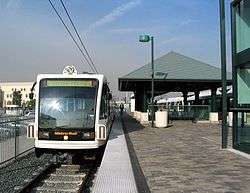
Light Rail service arrived at Union Station on July 26, 2003, when Metro's Gold Line began operating to Pasadena from tracks 1 and 2. The line was expanded south over US 101 in November 2009 with the opening of the Gold Line Eastside Extension.
In February 2011, the board of the Los Angeles County Metropolitan Transportation Authority (Metro) approved the purchase of Union Station from Prologis and Catellus Development (a descendant of the Santa Fe and Southern Pacific railroads) for $75 million. The deal was closed on April 14, 2011.[12][13] Since taking over ownership of the station, Metro has focused on increasing services for passengers at the station. One of the most noticeable changes is the addition of several retail and dining businesses to the concourse.
Amtrak opened a Metropolitan Lounge at Union Station on September 23, 2013.[14] The lounge is open to Amtrak passengers traveling in sleeping car accommodations or business class as well as some Amtrak Guest Rewards members (Select Plus and Select Executive levels only).[15] The lounge features a staffed ticket counter, complimentary refreshments, complimentary Wi-Fi, and a conference room. Passengers using the Metropolitan Lounge receive priority boarding.
Metro plans to install Bluetooth beacons in Union Station to enable sending text messages to travelers' smartphones.[16]
Architecture

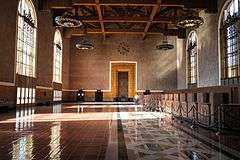
Union Station was partially designed by John Parkinson and Donald B. Parkinson (the Parkinsons) who had also designed Los Angeles City Hall and other landmark Los Angeles buildings. They were assisted by a group of supporting architects, including Jan van der Linden. The structure combines Art Deco, Mission Revival, and Streamline Moderne style, with architectural details such as eight-pointed stars, and even elements of Dutch Colonial Revival architecture (the suggestion of the Dutch-born Jan von der Linden).[17]
Enclosed garden patios are on either side of the waiting room, and passengers exiting the trains were originally directed through the southern garden. The lower parts of the interior walls are covered in travertine marble; the upper parts have an early form of acoustical tile. The floor in the large rooms is terra cotta with a central strip of inlaid marble (including travertine, somewhat unusual in floors since it is soft). The ceiling in the waiting room has the appearance of wood, but is actually made of steel.[18]
Attached to the main building to the south is the station restaurant designed by the famed Southwestern architect Mary Colter. It was the last of the "Harvey House" restaurants to be constructed as a part of a passenger terminal. Although padlocked and stripped of many interior furnishings, the topology of its vast rectangular space, rounded central counter, and streamlined booths remains. The spectacular inlaid cement tile floor[19] reproduces the pattern of a Navajo blanket.[20] Colter also designed a sleek, Streamline Moderne cocktail lounge, which is closed now as well. In October 2014, the Harvey House space was leased to leading local restaurateurs for a gastropub.
The original ticket concourse has 62-foot (19 m) high ceilings and a 110-foot (34 m) counter. Like the southern garden and Harvey House space, it is closed, but rented for filming and special events.[18][20][21][22]
Even with its grand scale, Union Station is still considered small in comparison to other union stations.[23]
From the late 1990s until 2019, Traxx restaurant was a "top draw" at Union Station, according to the Los Angeles Times. The restaurant was Art Deco-themed that reflected the history and architectural grandeur of its home. In May 2019, the restaurant closed.[24]
Location
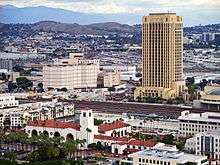

Union Station is located in the northeastern corner of Downtown Los Angeles, on the property bounded by Alameda Street, Cesar Chavez Avenue, Vignes Street, and the Hollywood Freeway. It is across Alameda Street from L.A.'s historic Olvera Street and El Pueblo de Los Angeles State Historic Park. The historic Terminal Annex building is on the opposite side of the Chavez Avenue underpass. Chinatown and Civic Center are a short distance away.
The site of the Tongva village of Yaanga, which was "believed to have been the largest of the Tongva villages," was in the vicinity.[25]
The Patsaouras Transit Plaza on the east side of Union Station hosts several connecting bus lines, including Metro Local, Metro Rapid and Metro Express lines, as well as downtown DASH shuttles, many municipal bus lines, FlyAway express bus service to Los Angeles International Airport, and University of Southern California campus shuttles. The Transit Plaza is named after Nick Patsaouras, former RTD board member and advocate for public transportation.
The Gateway Transit Center includes the station itself and the Patsaouras Transit Plaza, both of which were designed by Ehrenkrantz & Eckstut, along with the western terminus of the El Monte Busway, as well as Metro's headquarters building.
Amtrak and Metrolink share 12 of Union Station's 14 outdoor tracks, with 90 weekday trains departing (91 on Wednesday, 92 on Friday).
Services
Amtrak
Amtrak long-distance routes

Amtrak operates four long-distance trains out of Los Angeles:
- Coast Starlight, to Seattle (daily, service began 1971)
- Southwest Chief, to Chicago (daily, service began 1936 as Super Chief, renamed Southwest Limited in 1974 and Southwest Chief in 1984)
- Sunset Limited, to New Orleans (tri-weekly, service began 1894)
- Texas Eagle, to Chicago via San Antonio (tri-weekly, service began 1982) Cars bound for Chicago are part of the Sunset Limited to San Antonio, where the train is split.
Amtrak California regional routes
Amtrak California operates multiple-times-daily regional rail services to cities across the state:
- Pacific Surfliner, from San Diego to San Luis Obispo via Los Angeles (service began 1939 as San Diegan, renamed Pacific Surfliner in 2000)
- Connections to the San Joaquin train to Oakland or Sacramento are provided through Amtrak Thruway Motorcoach services. (see below)
Metrolink
The station is the hub for Metrolink and six of Metrolink's seven lines serve the station:
- Antelope Valley Line, to Lancaster (opened: October 26, 1992)
- Riverside Line, to Riverside (opened: June 14, 1993)
- Orange County Line, to Oceanside (opened: March 28, 1994)
- San Bernardino Line, to San Bernardino (opened: October 26, 1992)
- Ventura County Line, to Ventura (opened: October 26, 1992)
- 91/Perris Valley Line, to Perris (opened: May 6, 2002)
Metro Rail
Three Metro Rail lines (the B (Red), D (Purple), and L (Gold) Lines) serve the stations portal with about 300 Metro Rail trains departing every weekday.
Metro B Line/Metro D Line

The Metro B and Metro D subway lines have their eastern terminus at Union Station and share two tracks below Union Station.[26][27] There are two entrances: one is located inside Union Station's main concourse on the west side of the complex, near Alameda Street, and the other is located at the Patsaouras Transit Plaza on the downstairs east side of the complex.
Metro L Line
The Metro L Line (Gold) is a light rail line that passes through Union Station as it travels between Azusa and East Los Angeles.[28] Trains use Tracks 1 and 2 of Union Station's 14 outdoor tracks. The platform is accessible from the main passenger portal tunnel via staircase and elevator. From the Gold line's opening on July 26, 2003, until the segment to East Los Angeles opened on November 15, 2009, this station was the southern terminus. The platform features an art installation, entitled Images of Commonality/Nature and Movement, created by Beth Thielen.
The platform station will be served by Line A, which will run from Long Beach to Azusa, once the Regional Connector is complete in 2022.
Metro Busway
Metro J Line
One Metro Busway bus rapid transit line makes a stop outside Union Station. The Metro J Line (Silver) operates between El Monte Bus Station, Downtown Los Angeles, Harbor Gateway Transit Center and select trips to San Pedro using the El Monte Busway and Harbor Transitway. The Metro J Line stops near the southwest corner of the station at the entrance to the El Monte Busway at Alameda Street.

Bus and coach services
Long-distance motorcoach
Amtrak Thruway Motorcoach

Amtrak California operates several routes under the Amtrak Thruway Motorcoach brand from Union Station using dedicated bus bays at the north side of the station.
Connections to San Joaquin trains are provided through bus routes 1A & 1B that travel to and from the Bakersfield Amtrak Station.[29] Direct rail service to Bakersfield is not possible because passenger trains are not normally allowed on the Tehachapi Loop near Bakersfield.
- Route 1A: Bakersfield – Los Angeles
- Route 1B: Bakersfield – Los Angeles – San Pedro (serving the cruise terminals and Catalina Island ferries in Long Beach and San Pedro)
When trains are not running during the overnight hours several bus routes provide service along the Pacific Surfliner route (to Santa Barbara, San Diego and select intermediate stations) and the San Joaquin route (to Fresno and select intermediate stations.):
- Route 1A: Bakersfield – Los Angeles – San Diego
- Route 1A: Bakersfield – Los Angeles – Santa Ana
- Route 1B: Fresno – Bakersfield – Los Angeles
- Route 4: Santa Barbara – Los Angeles
Amtrak also offers a Thruway Motorcoach route to Las Vegas from Union Station.
California Shuttle Bus
While it does not stop on the Union Station property, California Shuttle Bus provides service to San Francisco, Oakland and San Jose from a bus stop across from the Patsaouras Transit Plaza at the corner of Vignes and Ramirez streets.
Flixbus
While it does not stop at the Union Station property, Flixbus provides intercity service from a parking lot at the corner of Cesar Chavez Avenue and Vignes Street.[30]
Megabus
Megabus operates three long-distance motorcoach routes from Berth 1 at the Patsaouras Transit Plaza:
Metro and municipal buses
Bus services using the Patsaouras Transit Plaza:
- Metro Local: 33 (late nights only), 40
- Metro Express: 442*
- Metro Rapid: 704, 728, 733, 745
- Antelope Valley Transit Authority: 785*
- City of Commerce Municipal Bus Lines: Citadel Outlets Express
- City of Santa Clarita Transit: 794*
- LAX FlyAway
- Foothill Transit: 699*
- LADOT Commuter Express: Bunker Hill Shuttle*, 431*, 534*
- LADOT DASH: D (weekdays only)
- Mount St. Mary's College Shuttle*
- Orange County Transportation Authority: 701*
- University of Southern California Shuttles: UPC, HSC, ICS
Bus services using the bus stop at the entrance to the El Monte Busway, west of Alameda Street (southwest corner of the Union Station property):
- Metro Busway: Metro J Line
- Metro Express: 487, 489*
- Foothill Transit: Silver Streak, 493*, 497*, 498*, 499*
Bus services using the bus stop on Cesar Chavez Avenue & Vignes Street (northeast corner of station):
- Metro Local: 68, 70, 71, 76, 78, 79, 378*
- Metro Rapid: 770
- LADOT DASH: Lincoln Heights/Chinatown
Bus services using the bus stop on Alameda Street & Los Angeles Street (outside western entrance):
- Big Blue Bus: Rapid 10
- LADOT DASH: B (weekdays only)
- Torrance Transit: 4*
Bus service using the bus stop on the west side of Union Station (near the taxi stand and the Mozaic Apartments):
- Dodger Stadium Express (home games during baseball season only)
- * Indicates commuter service that operates only during weekday rush hours.
Platforms and tracks
| Upper Level (Tracks 1-2)[31] | Southbound | ← ← |
| Island platform, doors will open on the left | ||
| Northbound | → → | |
| Upper Level (Tracks 3–14) | Eastbound | → 91/Perris Valley Line toward South Perris (Norwalk/Santa Fe Springs) → |
| Island platform, doors will open on the left or right | ||
| Northbound | → Antelope Valley Line toward Lancaster (Glendale) → | |
| Southbound | → Orange County Line toward Oceanside (Commerce) → | |
| Island platform, doors will open on the left or right | ||
| Eastbound | → Riverside Line toward Riverside (Montebello/Commerce) → | |
| Eastbound | → San Bernardino Line toward San Bernardino-Downtown (Cal State LA) → | |
| Island platform, doors will open on the left or right | ||
| Northbound | → Ventura County Line toward East Ventura (Glendale) → | |
| Northbound | → Coast Starlight toward Seattle (Hollywood Burbank Airport) → | |
| Island platform, doors will open on the left or right | ||
| Eastbound | → Southwest Chief toward Chicago (Fullerton) → | |
| Eastbound | → Sunset Limited toward New Orleans (Pomona) → | |
| Island platform, doors will open on the left or right | ||
| Eastbound | → Texas Eagle toward Chicago via San Antonio (Pomona) → | |
| Northbound | → Pacific Surfliner toward San Luis Obispo (Glendale) → | |
| Island platform, doors will open on the left or right | ||
| Southbound | → Pacific Surfliner toward San Diego (Fullerton) → | |
| Passageway | Exit/entrance, Ticket machines, Faregates, Patsaouras Transit Plaza, Historic station | |
| El Monte Busway/Alameda Street (Northbound) | ← | |
| El Monte Busway/Alameda Street (Southbound) | → | |
| Lower Level | Northbound/Westbound | ← ← |
| Island platform, doors will open on the left or right | ||
| Northbound/Westbound | ← ← | |
Future expansion
New transit station on El Monte Busway
A new transitway station for the Metro J Line and other transit buses operating on the El Monte Busway is planned to the south of the Patsaouras Transit Plaza, in the median of the El Monte Busway, funded by tolls collected as a part of the Metro ExpressLanes project.[32] It will allow buses traveling in both directions on the busway to serve Union Station while minimizing dwell time, according to Metro.[33][34]
The station was originally expected to be completed in June 2014, but because all bids came in over budget, they were cancelled and the Metro Board of Directors increased the budget and solicited new bids.[35] As of April 2017 the station is under construction, and is expected to open in the spring of 2018.[36]
Link Union Station

With the number of trains using Union Station expanding, the stub-end layout of trackage is limiting the station's capacity. Trains can only enter or exit from the north side of the station.[37] The configuration forces trains without cab-cars to slowly reverse in or out of the station and trains heading to or from the south to make a near-180 degree turn. Compounding the problem, is that while the station has 14 boarding tracks, multiple trains must squeeze onto just 5 tracks (originally, there were more tracks at "the throat", but Metrolink had some removed to allow for faster speeds along the curves in and out of the station to improve efficiency) as they enter or exit the station. This choke-point can delay arriving trains as they are forced to wait outside of the station to allow a departing train to exit the station (departures are usually given priority, to free up platforms and to keep them from experiencing delays along their route).
Therefore, Metro has proposed the Link Union Station (formerly titled the Southern California Regional Interconnector Project) which would extend tracks 3–10 as run-through tracks, which will exit Union Station and cross over US Route 101 on a long, elevated "S-curve" that will tie into the existing tracks along the Los Angeles River. The plan also includes tracks along the river that would create a "loop" around the station allowing all trains (including those to/from the north or west) to use the run-though tracks.[38]
Metro authorized preliminary engineering for the project in July 2012. A Request For Proposals (RFP) for Link Union Station was being prepared as of June 2013.[39] The $31-million contract for the engineering work on the project was approved on April 24, 2014.[40] The project's estimated value is $350 million.[40][41] A draft environmental impact report on Link Union Station is expected in 2017[42]
During construction, several tracks may be taken out of service due to their extension. To make up for the temporary loss of those platforms, track 13 was revitalized for use and tracks 14 & 15 were re-constructed. The project was completed on October 17, 2012.[43] Once the SCRIP project is finished, the run-through tracks and tracks 13–14 will be in regular use (track 15 will be used for storage), resulting in a 40% increase in track capacity.
On July 27, 2019, the Metro board approved environmental studies for the Link US Union Station run-through tracks project that includes an expanded central concourse hallway and eliminated loop tracks. These modifications reduced project costs while prioritizing rider convenience while transferring between trains. The board action officially certified the Link US Final Environmental Impact Report (FEIR),[44] and a funding plan for the project was approved on April 21, 2020, with the project's completion targeted for 2026.[45]
Former Run-Through Tracks Project
California Department of Transportation (Caltrans) and the Federal Railroad Administration previously drafted a plan to create run-through tracks at Union Station, but the project involved just four tracks and lacked the station "loop" limiting usage of the tracks just to trains heading to or from the south.
The final environmental impact report for the "Los Angeles Union Station Run-Through Tracks Project" was published by the FRA in November 2005.[46]
California High-Speed Rail
Union Station is planned to be a major hub for the future California High-Speed Rail System. Upon completion, it is projected that passengers will be able to get from Union Station to the Transbay Transit Center in the city of San Francisco in 2 hours and 40 minutes.[47]
As a part of its Master Plan, Metro is currently studying how to best integrate tracks and platforms for high-speed trains arrival into Union Station. Options include an aerial structure above the existing platforms, an underground structure under Alameda Street, an underground structure under Vignes and an aerial structure east of Vignes.[48] All plans include a new concourse for high-speed rail passengers and three platforms with six tracks.
In popular culture
The facility served as a backdrop for the 1950 film Union Station,[49][50] which starred William Holden and Nancy Olson. It has been used in many vintage motion pictures, many of the film noir variety. Movies that have featured Union Station as a filming location include:
- Blade Runner[51]
- Dead Men Don't Wear Plaid[52]
- Drag Me to Hell[53]
- Gable and Lombard[49]
- Bugsy[49]
- Pearl Harbor
- Chandler (film)[54]
- In the Mood[49]
- Private Eye (1987 TV movie starring Josh Brolin)[49]
- Silver Streak[55]
- The Way We Were[49]
- Trancers II: The Return of Jack Deth
- Under the Rainbow[49]
- To Live and Die in L.A.[56]
- Muppets Most Wanted
- The Island
- The Italian Job
- Cry Danger
- Union Station
- Garfield: The Movie
- The Dark Knight Rises[57]
See also
- List of Registered Historic Places in Los Angeles
- Los Angeles County Metro Rail
- Los Angeles County Metropolitan Transportation Authority
- Los Angeles Metro Rail rolling stock
References
- "Amtrak Fact Sheet, FY2018, State of California" (PDF). Amtrak. June 2019. Retrieved January 2, 2020.
- "National Register Information System". National Register of Historic Places. National Park Service. March 13, 2009.
- "Union Station > History". Los Angeles County Metropolitan Transportation Authority. Retrieved January 10, 2014.
- Corselli, Andrew (May 2, 2019). "The Union Station octogenarian celebration". Railway Age. Archived from the original on May 2, 2019. Retrieved May 8, 2019.
- "Metro Board approves Union Station Master Plan, allowing near-term projects to go forward | Metro's The Source". Thesource.metro.net. October 23, 2014. Retrieved December 23, 2015.
- "Los Angeles Union Station Master Plan". Metro. Retrieved January 31, 2013.
- Axelrod, Jeremiah (2009). Inventing Autopia: Dreams and Visions of the Modern Metropolis in Jazz Age Los Angeles. University of California Press. pp. 188–193. ISBN 9780520252851.
- Bottles, Scott (1987). Los Angeles and the Automobile: The Making of the Modern City. Berkeley, California: University of California Press. p. 156. ISBN 978-0-520-05795-1.
- Bengtson, John (2010). Silent Traces: Discovering Early Hollywood Through the Films of Charlie Chaplin. Lobster Films.
- "Ontario's Mule, Gravity Car in Parade at L. A.". San Bernardino Daily Sun. San Bernardino County, California. May 4, 1939. p. 14. Retrieved November 16, 2018.
- Katches, Mark (January 31, 1993). "Red Line Rolls to Raves – It's Smooth Railing As L.A. Subway Opens". Daily News of Los Angeles.
- "Metro to purchase Los Angeles Union Station". The Source. Los Angeles County Metropolitan Transportation Authority. February 24, 2011. Retrieved January 10, 2014.
- "Metro tonight officially becomes new owner of Los Angeles Union Station". The Source. Los Angeles County Metropolitan Transportation Authority. April 14, 2011. Retrieved January 10, 2014.
- "Los Angeles Metropolitan Lounge opening next Monday, 9/23". FlyerTalk. Retrieved September 19, 2013.
- "Station Lounges". Amtrak. Retrieved December 23, 2015.
- Nelson, Laura J. (February 3, 2015). "Beacon technology to target Union Station visitors with help, commerce". Los Angeles Times. Retrieved June 8, 2015.
- Waldie, D.J. (May 1, 2014) "Union Station: L.A.'s nearly perfect time machine" Op-Ed, Los Angeles Times.
- Allen, Dan (May 2014). "Forming a More Perfect Union". Westways. Automobile Club of Southern California: 53.
- "Reflections on Union Station: an essay by Stephen Fried". June 19, 2014. Retrieved August 12, 2018.
- Vanessa (February 6, 2010). "L.A. Places: Union Station Harvey House". Laplaces.blogspot.com. Retrieved December 23, 2015.
- "Traxxrestaurant.com". Traxxrestaurant.com. Retrieved December 23, 2015.
- "Union Station - 800 North Alameda Blvd., Los Angeles, CA 90012 | Filming Locations | Location Scouts, Managers, and Agency". Hollywood Locations. October 12, 2009. Retrieved December 23, 2015.
- Poole, Matthew R. (2010). Frommer's Los Angeles 2011. Frommer's. p. 30. ISBN 978-0-470-62619-1.
- Shalby, Colleen (May 21, 2019). "At 80, Union Station tries to reinvent itself for a rail future". Los Angeles Times. Retrieved May 23, 2019.
- Greene, Sean; Curwen, Thomas. "Mapping the Tongva villages of L.A.'s past". LA Times. Retrieved June 19, 2019.
- "Red Line Map and Station Locations". Los Angeles County Metropolitan Transportation Authority. Retrieved February 2, 2014.
- "Purple Line Map and Station Locations". Los Angeles County Metropolitan Transportation Authority. Retrieved February 2, 2014.
- "Gold Line Map and Station Locations". The Source. Los Angeles County Metropolitan Transportation Authority. Retrieved February 2, 2014.
- "Amtrak California Operating Timetable No.45" (PDF). Caltrans. Retrieved February 1, 2013.
- "Bus to los Angeles, CA from $4.99 | FlixBus → the New Way to Travel".
- "Union Station layout map" (PDF). Metro. Retrieved March 10, 2014.
- "Metro ExpressLanes". Los Angeles County Metropolitan Transportation Authority. Retrieved January 11, 2014.
- "Patsaouras Plaza/El Monte Busway Station". www.eekarchitects.com. Ehrenkrantz Eckstut & Kuhn Architects. Retrieved January 11, 2014.
- "Patsaouras Plaza Connector (Conceptual Plan)". flickr.com. May 12, 2009. Retrieved January 11, 2014.
- "Patsaourus Plaza Busway Station (PPBS) Approve Increase To Life-of-Project Budget" (PDF). Los Angeles County Metropolitan Transportation Authority. January 16, 2014. p. 5. Retrieved February 2, 2014.
- Radio, Southern California Public (January 2, 2017). "Construction underway on Union Station pedestrian bridge". Retrieved August 12, 2018.
- Slayton, Nicholas. "Metro Outlines Plans for Faster Train Service with Link Union Station". Los Angeles Downtown News - The Voice of Downtown Los Angeles. Retrieved February 21, 2019.
- "Regional Rail Capital Funding Plan For FY 2012–13" (PDF). Los Angeles County Metropolitan Transportation Authority. July 18, 2012. Retrieved July 3, 2013.
- "Planning and Programming Committee – June 19, 2013 – Regional Rail Update" (PDF). Los Angeles County Metropolitan Transportation Authority. June 19, 2013. Retrieved July 3, 2013.
- Hymon, Steve (April 24, 2014). "Metro Board approves contract for Union Station regional rail improvements". The Source. Los Angeles County Metropolitan Transportation Authority. Retrieved April 24, 2014.
- Weikel, Dan (May 27, 2014). "Union Station to get $350 million in track upgrades". Los Angeles Times. Retrieved May 28, 2015.
- "Link Union Station (Link US)". Los Angeles County Metropolitan Transportation Authority. Retrieved January 6, 2017.
- Hymon, Steve (October 17, 2012). "Ribbon cutting this morning for new platform at Los Angeles Union Station!". The Source. Los Angeles County Metropolitan Transportation Authority. Retrieved July 3, 2013.
- Linton, Joe (June 28, 2019). "Metro Board Approves Link US Union Station Run-Through Tracks". Streetsblog LA. streetsblog.org. Retrieved September 14, 2019.
- Sharp, Steven (April 22, 2020). "California High Speed Rail Authority Approves Funding Plan for Union Station Upgrades". Urbanize Los Angeles. Urbanize Media LLC. Retrieved April 25, 2020.
- "Los Angeles Union Station Run-Through Tracks Project". Federal Railroad Administration (FRA). Retrieved July 3, 2013.
- "CALIFORNIA STREETS AND HIGHWAYS CODE SECTION 2704.09 (b) (1)". www.leginfo.ca.gov. Retrieved July 13, 2013.
- "Union Station Master Plan Presentation" (PDF). Los Angeles County Metropolitan Transportation Authority. pp. 38–66. Retrieved July 13, 2013.
- Smith, Leon (1988). Hollywood Goes on Location. Los Angeles: Pomegranate Press. pp. 179–181. ISBN 0-938817-07-8.
- Union Station on IMDb
- Bible, Karie (2010). Location Filming in Los Angeles. Arcadia Publishing. p. 27. ISBN 9780738581323.
- "Union Station". www.flickr.com. Retrieved January 11, 2014.
- "Internet Movie Cars Database". Retrieved January 11, 2014.
- "Internet Movie Database". Retrieved December 3, 2016.
- "Internet Movie Cars Database". Retrieved January 11, 2014.
- "Filming Locations". Retrieved August 7, 2015.
- "Culture Trip". Retrieved September 8, 2019.
Further reading
- Musicant, Marlyn, ed., with Deverell, William and Roth, Matthew W. Los Angeles Union Station (Los Angeles): Getty, 2014. xvi, pp. 109; heavily illustrated.
External links
| Wikimedia Commons has media related to Union Station (Los Angeles). |
- Los Angeles, CA – Amtrak
- Union Station overview (Metrolink)
- LA Metro map of connections in the Union Station area
- LA Metro map of bus services from Union Station
- Great American Stations listing (Amtrak)
- Los Angeles station information (Amtrak Texas Eagle)
- Public Art Works at the Union Station and in El Pueblo
- "Union Station" Visiting... with Huell Howser (Episode 222 – September 26, 1994)
_edit1.jpg)

